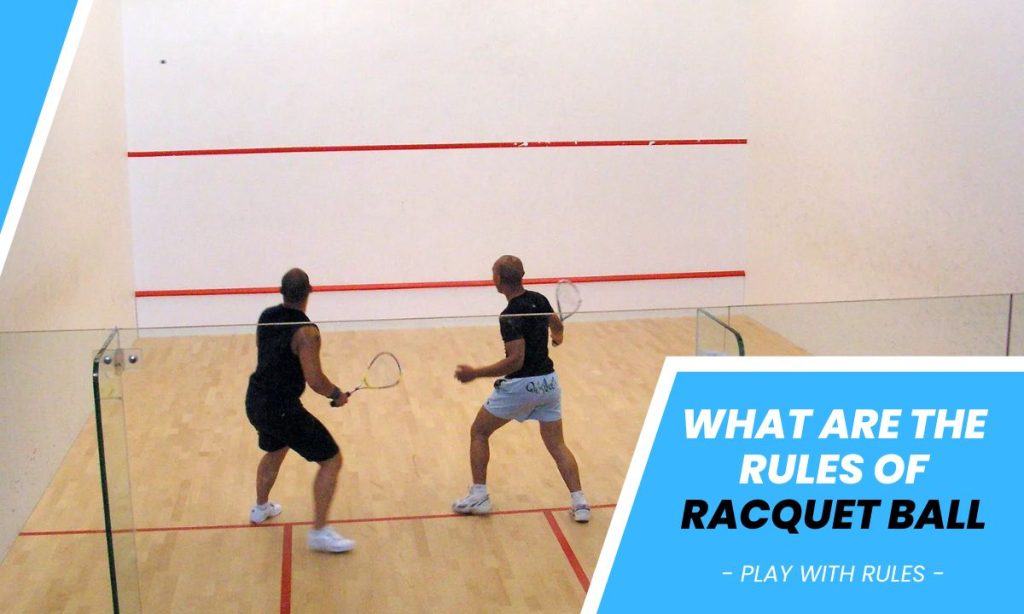Nowadays, sports aren’t limited to only a few traditional games. With its wider version of several competitive sports, one sport whose popularity has been skyrocketing is Racquetball. That’s why many are eager to learn about Racquetball rules as well. Well, the name already suggests how the game is played- hit the ball with the racquet. And believe us, it is a high-octane, high-adrenaline sport that you will never get enough of!
Now, let’s explore the world of racquetball, learn about its rules, and explore a few important tips and strategies that might help us improve. Without further ado, let’s get into it!
Table of Contents
How To Play Racquetball?
Before delving into What Are The Rules Of Racquetball and how to play it, let’s first gain an understanding of what racquetball is. Racquetball is a game that may be called a derivative of tennis and squash. However, there are key differences in each of these games. For example, the equipment that you need in racquetball or even the court regulations vary largely. The way the game is played and the way players score points in racquetball is also different.
In racquetball, two players attempt to outscore each other by hitting a ball against the front walls, side walls, and roof using a racquet by following the racquetball rules. The idea is to make your opponent miss, just like in tennis. However, in racquetball, instead of facing each other, both players face the same wall, and the game is played within the same half of the court. If you consider yourself to be fiercly competitive, you will enjoy a game of racquetball like no other!
Bonus: You can call your friends to join you. That’s because Racquetball can also be played as doubles.
The Objective
Both players smash the ball into the surrounding walls using a racquet to keep a rally going (when serving, only the front wall is permissible). The first player to lose that rally loses a point. The winner of the rally then serves.
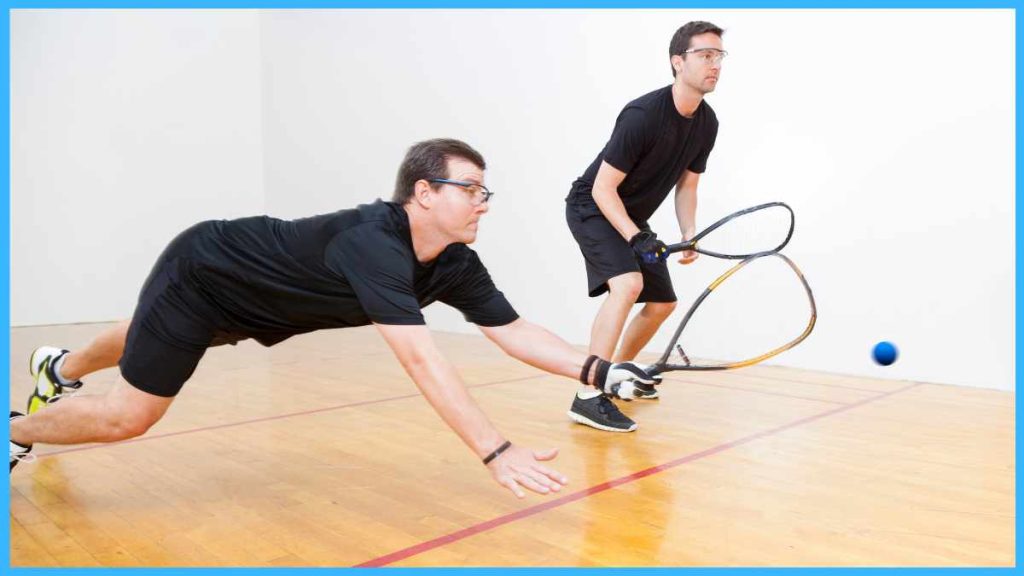
Racquetball Rules
We get it – Racquetball sounds like a blast (and it really is)! But hold your horses! Knowing what are the rules of racquetball is the first step in playing racquetball. So, let’s be well-versed with the rules and regulations before we start talking about the game and strategies.
To start playing racquetball, two players are needed (however, it is also a popular doubles sport, so you can play with four players as well). Then, the two players can either do a coin toss or a racquet flip. The player who wins gets to serve first,as per the Rules Of Racquetball. Then, the game proceeds as per the rules, and the players are to keep the rally going. Eventually, when one of the players loses a point (fails to keep the rally going), the other player gets to serve. This continues till the game is over.
General Rules (Singles)
When playing racquetball in the singles format, there are three basic regulations that need to be highlighted. These are the general racquetball single rules:
- In the first game, the player who wins the toss serves first. In the second game, the alternate player serves first. The player with the highest cumulative points gets to serve for the final match.
- But according to the racquetball rules, the ball must bounce twice before serving, and then it needs to hit the front wall.
- Generally, ‘hinders’ calls for a replay. However, if it is a penalty hindrance (hindering a point-scoring shot), the opponent is awarded a point, or the serve returns to him.
General Rules (Doubles)
The racquetball doubles rules are as follows:
- In doubles, each team picks a server who is to serve for the rest of that match. The other player in the team gets to serve in the following game.
- Further, each team must nominate one player to receive either in the right or left service box.
- When rallying, all players must take turns striking the ball. For instance, the order should be the server, the receiver, the server’s partner, the receiver’s partner, and so on.
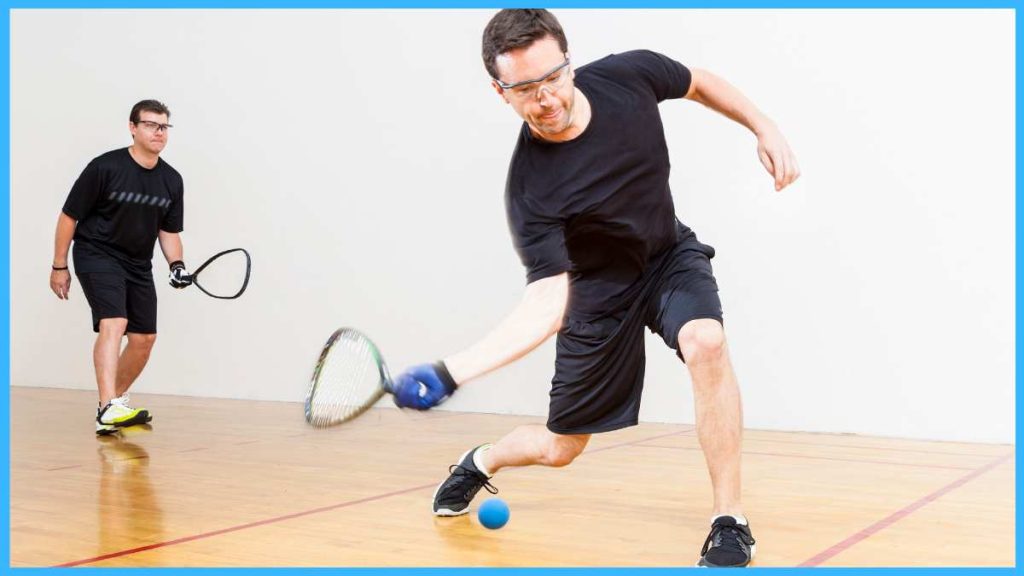
Court Lines And Regulations
Before we discuss scoring points or explain the racquetball rules in general, the first thing you need to understand is the court and what each line signifies. This is crucial because this is the premise for the rules of racquetball.
Service Line
Now that you know what are the rules of racquetball, this is the first line in the general service area. It is closest to the front wall, and the player serving must have both feet on the line or behind it. If a player’s foot extends beyond this line (either side), it is called a ‘foot fault,’ and the serve automatically goes to the other person/team.
Short Line
This line runs through the middle of the court and divides it into two equal halves. The role of this line is as follows:
- When serving, the ball must bounce off the front wall and cross the short line. It is declared a fault if it bounces off the floor before crossing the short line.
- The server cannot have his feet crossing the short line (behind it). If the foot extends beyond it, it is considered a fault.
- However, per racquetball, the server can only go behind the short line once the served ball crosses it.
Service Zone
The service area is the rectangular area between the service line and the short line. The player serving has to be within the service zone and can only go beyond it after the served ball crosses the short line.
Service Boxes
These are nothing but two rectangular boxes on either side of the service zone, closest to the walls. They are used only when playing doubles.
Receiving Line
As per racquetball rules, this is the last line on the court. The player returning the serve can only cross the receiving line once the following has happened:
- The ball crosses the short line and bounces.
- The ball crosses the receiving line in the air.
NOTE: According to racquetball rules, if the player returning the serve steps on the receiving line or crosses it before either of the above happens, it is declared a fault, and the opposition is awarded a point.
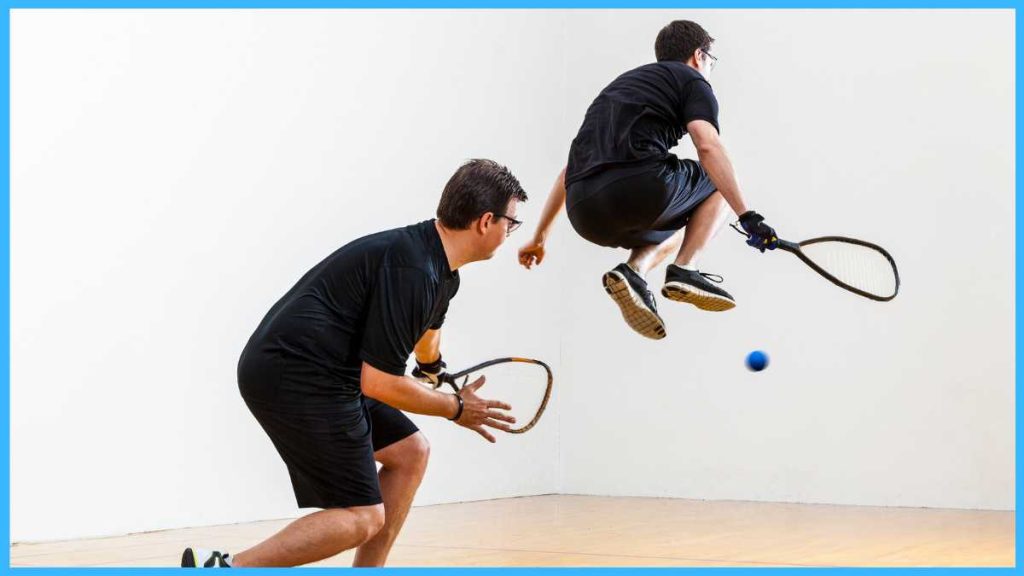
Service
Racquetball is a game that gives a lot of importance to the service as it decides the flow of the game. Naturally, there are certain guidelines/rules for serving. They are:
- The server needs to bounce the ball twice before serving.
- For that, the ball needs to bounce off the front wall before it crosses the short line.
- The rally can begin after the served ball has hit the front wall and crossed the short line, per racquetball rules.
- If the served ball touches the other player before touching the ground, the server gets another attempt at serving.
- However, if the server swings and misses his serve, he will get another try at serving.
- The server also gets another try if the served ball hits any other ball before hitting the front wall.
- Lobbed serves and drive serves are the most prominent racquetball serves, as per the rules of racquetball
Service Faults & Penalty
With service comes service faults – and obviously, if racquetball rules are not followed, teams can be penalized. So, what are the rules when it comes to service faults or penalties? Let’s find out:
- Foot Faults (refer to the Receiving Line section above)
- Short Serves – When the ball hits the front wall but bounces off the floor before crossing the short line.
- Three-wall serve – When the ball hits the front wall but hits both side walls before touching the floor.
- Ceiling serve – When the ball bounces off the front wall and hits the ceiling.
- Long serve – When the ball hits the front wall and hits the back wall before bouncing off the ground.
- Screen serve – When the served ball returns too close to the server and the opponent is unable to see it.
- Hindering shots can either result in a replay or a penalty.
Definition: Hindering is when players get between the wall and their opponent. But aiming directly at the opponent is also considered to be hindering.
Rallying
Rallying occurs when two players play two or more shots consecutively and return each other’s legal shots/serves, per racquetball rules.
- A rally begins after a successful serve.
- In a rally, the ball can be hit against any wall. However, it must hit the front wall before touching the floor.
- But according to the rules of racquetball, one thing to remember is that the served ball cannot hit the floor twice in a row.
Shots
Here are the shots that are most commonly practiced and encouraged in the world of racquetball:
- Straight-in—When the ball is hit directly at the front wall and returns parallel to the side walls, it is called a ‘straight-in.’ However, it is a difficult shot to return.
- Cross-court shot – When the ball is hit with force against the opposite corner of the front wall, it is termed a ‘cross-court shot.’ This makes the opponent move towards the side of the court and keeps the center clear, increasing your chance at scoring.
- Pinch shot—This shot happens when the ball is hit low and toward the far end of the side wall so that it immediately hits the front wall afterward. It is a kill shot and is played with the intention of not allowing the opponent to return the shot.
- Splat shot – The splat shot is the same as the pinch shot, but in this case, the ball is hit at the side wall close to the returning player instead of the far wall.
- Ceiling shot—This shot involves the ball hitting the front wall at a particular elevation before hitting the ceiling next. This also compels your opponent to move from the center of the court.
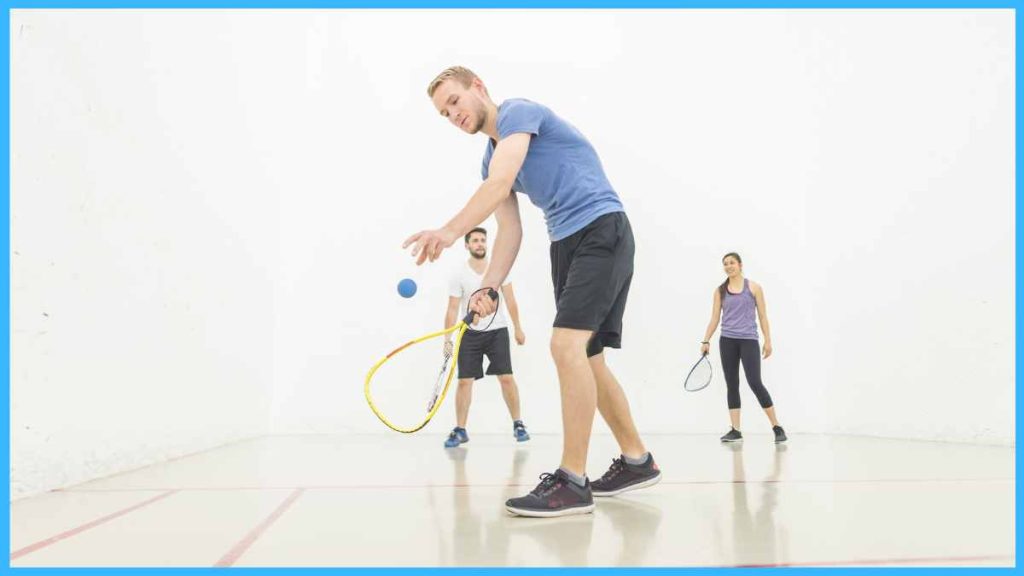
Losing A Point
Points can only be scored on your own serve. If your opponent is serving and you ‘win’ the rally, you don’t actually win a point. Instead, you win a serve, according to the official racquetball rules. Then, if you win your serve, you get a point. You can lose points if the following happens:
- The ball hits the floor more than once before you return the strike.
- The ball bounces off the floor or doesn’t hit the front wall before bouncing when you return.
- If the ball goes out-of-bounds when you play your shot.
- The ball hits the server first.
- If the ball hits the other player but doesn’t hit the front wall.
- You switch your hands when holding the racquet during the game.
- If you touch the ball with your clothes or any part of your body.
- Double hits.
- If you make two illegal serves consecutively.
Keeping Score
Before you get carried away by the thrill of it, here’s how to keep score so that you know who takes the win:
- The first match is played for 15 points.
- The second match is played for 15 points.
- The third match/deciding match (only played if necessary or tied) is played for 11 points.
Tips And Strategies
Here are a few tips to help you improve your ‘racquet’ game:
- Perfect the forehand grip (the grip you assume when shaking someone’s hand). Hold the racquet by the middle of the handle or towards the lower end to get that swing and power behind the ball.
- Don’t hold the racquet perpendicular to your hand, making it harder to serve and return with power.
- Practice the backhand grip. Use the standard forehand grip and turn it clockwise. Swing it from your head to pack a punch in your backhand shot.
- Switch it up with the height at which you hit the ball to keep the opponent guessing and running. This will tire them out quickly.
- Keep your shots low and powerful. This will keep your opponent from returning, and you will end the rally (with either a point or a serve).
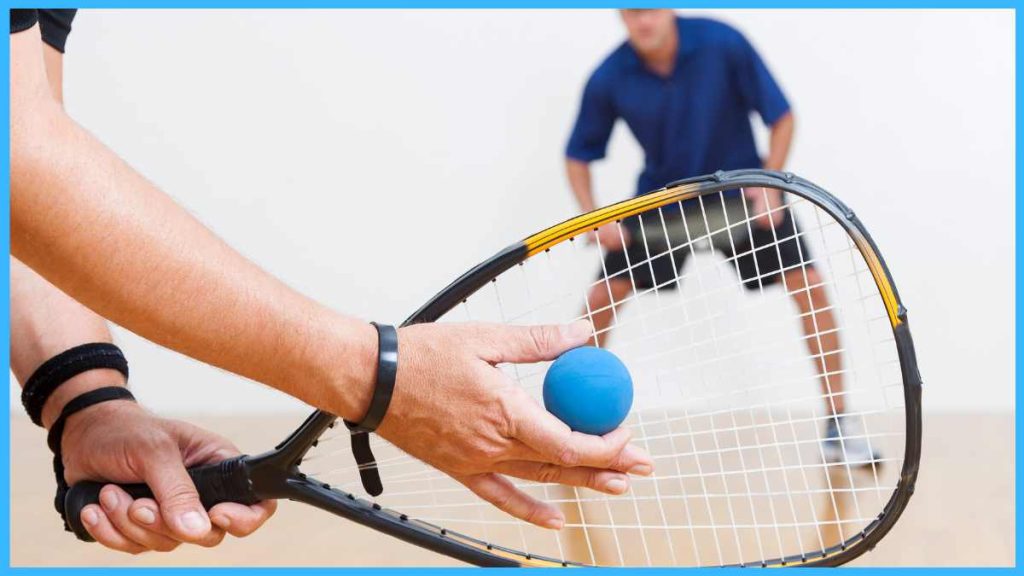
Winning Racquetball
Winning is quite simple if you follow the official racquetball rules. To win in this game, one player must win either 2 of 3 matches or the majority of a previously agreed-upon number of matches (odd number of matches only). The first player to score 11 points wins. However, if the score is tied at 10-10, then the player who secures a two-point lead first wins the game.
Racquetball Court And Equipment
A racquetball court bears a striking resemblance with a squash court – but only at first glance. According to standard racquetball rules, the dimensions of a standard racquetball court are 40 feet (long), 20 feet (wide), and 20 feet (high).
In racquetball, players can wear protective eyewear. It is not mandatory, but nobody wants a flying ball in the eye when playing competitively. The racquet used in racquetball is 22 inches or shorter in length. It is shorter than the racquet used in squash but is definitely broader.
Did You Know?
- Racquetball was originally referred to as paddle racquet.
- Joe Sobek invented racquetball back in 1950.
- The game’s rules were finally codified in 1952.
- The International Racquetball Association is the sport’s official governing body and was founded in 1969.
- The US Olympic Committee has recognized the sport.
- The UK variant of racquetball is called racketball.
FAQs
Can three people play racquetball?
Yes. It is called cutthroat racquetball. In this game, each player and the server start by playing against the other two players.
Is racquetball an Olympic sport?
The US Olympic Committee has recognized racquetball, but it has yet to be an Olympic sport.
How many rounds do I play in racquetball?
The general rule suggests three games, and the first player to win 2 of the three matches wins the game. However, if necessary, the game can be extended to 5 or even seven rounds.
Can I hit a body shot in racquetball?
Yes, but not with the intention of injuring your opponent. Also, there are certain rules about taking a body shot, and you best be careful.
Can I return a racquetball serve before it bounces?
No, you cannot return a racquetball serve before it bounces. The ball must bounce once on the court before you can hit it back. Returning it before it bounces results in a fault.
Can you hit 3 walls on a racquetball serve?
Yes, you can hit up to three walls on a racquetball serve. The ball must hit the front wall first and then can hit the side walls or the back wall before landing in the service box.
Can you hit the ball off the back wall in racquetball?
Yes, you can hit the ball off the back wall in racquetball. This is a legal shot and is often used strategically to change the direction of play or to catch your opponent off guard.
There is little room for error in racquetball, but the fun is unlimited once you master the basic rules of racquetball. Perfect your grip, and take your time to figure out the court. If you know the rules by heart, there is no telling how many games you can win. So start practicing your backhand stroke today!
Think you know enough? Get, set, and Roll! Keep coming back to Play With Rules for more such impactful learning on sports around the world.
Read More: Do you want to know how to play Golf Card Game? Click here

